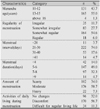Abstract
Purpose
Dysmenorrhea is one of the most common gynecologic complaints of young women. This study investigated the changes in the menstrual cycle during test evaluations according to perfectionism and testing anxiety among high school girls in order to provide information for care of dysmenorrhea.
Method
Data collection was done from July 14 to 18, 2008 by self administered questionnaires with 300 high school girls.
Result
The subjects experienced amenorrhea (35.3%), changes in the menstrual cycle (66.3%), changes in menstrual duration (50.0%), changes in amount of menstruation (47.7%), and increases in menstrual pain during testing evaluations. There were significant differences in changes of menstrual patterns, physical symptoms, and menstrual pain during test evaluations between a high perfectionist group and low perfectionist group. Also, there were significant differences in changes of menstrual patterns, physical symptoms, and menstrual pain during test evaluations between a high testing anxiety group and low testing anxiety group. Perfectionism and testing anxiety showed a positive relationship with changes in menstrual patterns, physical symptoms, and menstrual pain.
Figures and Tables
Table 5
Changes of menstrual patterns, physical symptoms, and menstrual pain between low perfectionism group and high perfectionism group during test evaluations (N=300)

References
1. Banikarim C., Chacko M.R., Kedler S.H. Prevalence and impact of dysmenorrhea on Hispanic female adolescents. Arch Pediatr Adolesc Med. 2000. 154(12):1226–1229.
2. Berek J.S, editor. Novak's Gynecology. 2006. 14th ed. Philadelphia: Lippincott Williams & Wilkins.
3. Cho S.C. Concept and theory of test anxiety. Korean J Child & Adol Psychiatr. 1991. 2:3–10.
4. Choi W.H., Moon E.S. The differences of test anxiety as a function of perfectionists in high school students. The Korean J Edu Psychology. 2004. 18(1):23–35.
5. Goldstein-Ferber S., Granot M. The association between somatization and perceived ability: Roles in dysmenorrhea among Israeli Arab adolescents. Psychosom Med. 2006. 68:136–142.
6. Harlow S.D., Park M. A longitudinal study of risk factors for the occurrence, duration and severity of menstrual cramps in a cohort of college women. Br J Obstet Gynaecol. 1996. 103(11):1134–1142.
7. Hewitt P.L., Caelian C.F., Flett G.L., Sherry S.B., Collins L., Flynn C.A. Perfectionism in children: Associations with depression, anxiety, and anger. Pers Individ Dif. 2002. 32(6):1049–1061.
8. Holmlund U. The experience of dysmenorrhea and its relationship to personality variables. Acta Psychiatr Scand. 1990. 82(2):182–187.
9. Jang H.J. The moderating effects of self-efficacy on the relationships between perfectionism and test anxiety of children. 2006. Seoul: Sookmyung Women's University;Unpublished master's thesis.
10. Jeong I.S. A study on the relation between the attitude and psychological dispositions about menstruation of high school girls. 2006. Masan: Kyungnam University;Unpublished master's thesis.
11. Kang H.Y. A study on correlation between female high school students' test anxiety, and their menstrual dysfunction, dysmenorrhea and menstrual pains. 2008. Chunchon: Kangwon National University;Unpublished master's thesis.
12. Kim E.Z., Kim H.J. Premenstrual syndrome and personality. J Korean Acad Nur. 1988. 18(1):80–93.
13. Kim J.S. The relations among premenstrual syndrome, menstrual attitude, neuroticism, and stress. 1998. Seoul: Seoul National University;Unpublished master's thesis.
14. Lee J.Y., Kang B.J. A comparison of menstrual condition and premenstrual symptoms between women with or without premenstrual depressive syndrome. J Korean Neuropsychiatr Ass. 1987. 26(3):554–561.
15. Lin H.T., Lin L.C., Shiao J.S. The impact of self-perceived job stress on menstrual patterns among Taiwanese nurses. Ind Health. 2007. 45:709–714.
16. Min S.K., Min S.H. The relationship between the normal menstrual cycle and anxiety. J Korean Neuropsychiatr Ass. 1988. 27(1):151–158.
17. Park G.L. A study on the stress and the complaint of the menstruation of the girls high school students. 1988. Seoul: Yonsei University;Unpublished master's thesis.
18. Park H.J. How perfectionism relates to test anxiety: Testing a mediation model of academic self-efficacy in high school students. 2005. Daejeon: Chungnam National University;Unpublished master's thesis.
19. Shin S.H. Factors related to the frequency of menstrual pain among women's high school students in an urban area. 2006. Daejeon: Chungnam National University;Unpublished master's thesis.
20. Silberg J.L., Martin N.G., Heath A.C. Genetic and environmental factors in primary dysmenorrhea and its relationship to anxiety, depression, and neuroticism. Behav Genet. 1987. 17(4):363–383.
21. Song A.R. A study on correlation between personality and premenstrual syndrome. The Korean Central J Med. 1990. 55(10):665–670.
22. Spielberger C.D., Anton W.D., Bedell J.. Zuckerman M., Spielberger C.D, editors. The nature and treatment of test anxiety. Emotion and anxiety: New concepts, methods and applications. 1976. Hillsdale, NY: Lawrence Erlbaum Associates.
23. Walsh R.N., Budtz-Olsen I., Leader C., Cummins R.A. The menstrual cycle, personality, and academic performance. Arch Gen Psychiatry. 1981. 38(2):219–221.
24. Wang L., Wang X., Wang W., Chen C., Ronnennberg A.G., Guang W., Huang A., Fang F., Zang T. Stress and dysmenorrhea: a population based prospective study. Occup Environ Med. 2004. 61:1021–1026.
25. Woods N.F. Relationship of socialization and stress to perimenstrual symptoms, disability, and menstrual attitudes. Nurs Res. 1985. 34(3):145–149.




 PDF
PDF ePub
ePub Citation
Citation Print
Print








 XML Download
XML Download